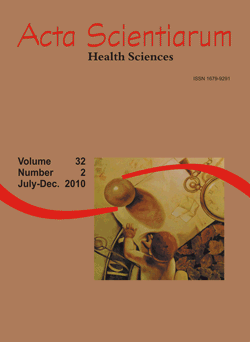<b>Influence of package and storage on the content of beta-carotene and ascorbic acid in industrialized “Ubá” mango juice</b> - doi: 10.4025/actascihealthsci.v32i2.6178
Keywords:
Storage, tetra pak package, glass container, antioxidants
Abstract
This work investigated the content and stability of two natural antioxidants – β-carotene and ascorbic acid (AA) – in mango juice industrialized and stored during different storage times, correlating the recommendations of vitamins A and C with the content found in the juice. β-carotene and AA were analyzed in juice sold in tetra pak packaging, during five storage times (1 to 5 months) and in glass containers, during three storage times (after 3, 4 and 5 months of storage). The analysis was carried out using High Performance Liquid Chromatography (HPLC). No statically differences (α = 5 %) were found between the different times of storage for both compounds analyzed, both in tetra pak package and glass container. Furthermore, no significant differences were found between the β-carotene content of the juices sold in both containers. However, we found statistical differences in AA levels between the different packages, with glass containers showing greater content compared to tetra pak packaging. Thus, losses occasioned by package permeability to oxygen should be subject of concern in the food industry.Downloads
Download data is not yet available.
Published
2010-09-28
How to Cite
Oliveira, D. da S., Mata, G. M. S. C., Lucia, C. M. D., Campos, F. M., Ribeiro, S. M. R., & Pinheiro-Sant’Ana, H. M. (2010). <b>Influence of package and storage on the content of beta-carotene and ascorbic acid in industrialized “Ubá” mango juice</b> - doi: 10.4025/actascihealthsci.v32i2.6178. Acta Scientiarum. Health Sciences, 32(2), 191-198. https://doi.org/10.4025/actascihealthsci.v32i2.6178
Issue
Section
Nutrition
DECLARATION OF ORIGINALITY AND COPYRIGHTS
I Declare that current article is original and has not been submitted for publication, in part or in whole, to any other national or international journal.
The copyrights belong exclusively to the authors. Published content is licensed under Creative Commons Attribution 4.0 (CC BY 4.0) guidelines, which allows sharing (copy and distribution of the material in any medium or format) and adaptation (remix, transform, and build upon the material) for any purpose, even commercially, under the terms of attribution.
Read this link for further information on how to use CC BY 4.0 properly.























5.png)







